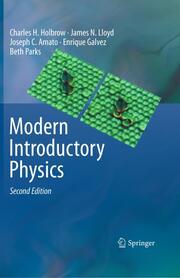Detailansicht
Modern Introductory Physics
Holbrow, Charles H/Lloyd, James N/Amato, Joseph C et al
ISBN/EAN: 9780387790794
Umbreit-Nr.: 1684644
Sprache:
Englisch
Umfang: xxi, 658 S., 45 s/w Tab.
Format in cm:
Einband:
gebundenes Buch
Erschienen am 23.09.2010
Auflage: 2/2010
- Zusatztext
- Thisbookgrewoutof anongoing e?orttomodernizeColgate University's three-term,introductory,calculus-level physicscourse. Thebookisforthe ?rst term of this course and is intended to help ?rst-year college students make a good transition from high-school physics to university physics. Thebookconcentrates onthephysicsthatexplainswhywebelievethat atoms exist and have the properties we ascribe to them. This story line, which motivates much of our professional research, has helped us limit the material presented to a more humane and more realistic amount than is presented in many beginning university physics courses. The theme of atoms also supports the presentation of more non-Newtonian topics and ideas than is customary in the ?rst term of calculus-level physics. We think it is important and desirable to introduce students sooner than usual to some of the major ideas that shape contemporary physicists' views of the nature and behavior of matter. Here in the second decade of the twenty-?rst century such a goal seems particularly appropriate. The quantum nature of atoms and light and the mysteries associated with quantum behavior clearly interest our students. By adding and - phasizing more modern content, we seek not only to present some of the physics that engages contemporary physicists but also to attract students to take more physics. Only a few of our beginning physics students come to us sharply focused on physics or astronomy. Nearly all of them, h- ever, have taken physics in high school and found it interesting.
- Kurztext
- Modern Introductory Physics, 2nd Edition, by Charles H. Holbrow, James N. Lloyd, Joseph C. Amato, Enrique Galvez, and Beth Parks, is a successful innovative text for teaching introductory college and university physics. It is thematically organized to emphasize the physics that answers the fundamental question: Why do we believe in atoms and their properties? The book provides a sound introduction to basic physical concepts with particular attention to the nineteenth- and twentieth-century physics underlying our modern ideas of atoms and their structure. After a review of basic Newtonian mechanics, the book discusses early physical evidence that matter is made of atoms. With a simple model of the atom Newtonian mechanics can explain the ideal gas laws, temperature, and viscosity. Basic concepts of electricity and magnetism are introduced along with a more complicated model of the atom to account for the observed electrical properties of atoms. The physics of waves---particularly light and x-rays---and basic features of relativity are explored and used to reveal further details of atomic structure. Following the discovery of radioactivity, transmutation, and the atomic nucleus, Bohr's model of the hydrogen atom sets the stage for a view of the atom that becomes fully modern with the introduction of the ideas of quantum mechanics. This book presents these ideas in terms of the Heisenberg uncertainty principle and Feynman's rules of quantum mechanics and also discusses the intriguing topics of entanglement, non-locality, and Bell's inequalities. Here, as everywhere in this book, there is strong emphasis on experiments and observable phenomena that have shaped and confirmed the concepts of physics.To help students make a good transition from high-school physics to university physics, this book fosters quantitative skills: There is much use of order-of-magnitude calculations, scaling arguments, proportionalities, approximations, and other basic tools of quantitative reasoning, progressing from simple and direct applications in the early parts of the book to more elaborate ones later. The book shows how new physics and new ideas are inferred from experimental data and quantitative reasoning. A large number of exercises and problems help students clarify their understanding. Modern Introductory Physics, 2nd Edition, is an extensive revision of the original influential and innovative introductory text. This new edition includes: improved exposition of some difficult topics two new chapters that explore important and intriguing ideas of quantum mechanics in the context of real experiments many updated problems for students new questions added to many chapters
- Autorenportrait
- InhaltsangabeWhat's Going On Here?.- Some Physics You Need to Know.- The Chemist's Atoms.- Gas Laws.- Hard-Sphere Atoms.- Electric Charges and Electric Forces.- Electric Fields and Electric Forces.- Magnetic Field and Magnetic Force.- Electrical Atoms and the Electron.- Waves and Light.- Time and Length at High Speeds.- Energy and Momentum at High Speeds.- The Granularity of Light.- X-Rays.- Particles as Waves.- Radioactivity and the Atomic Nucleus.- Spectra and the Bohr Atom.- The Heisenberg Uncertainty Principle.- Atoms, Photons, and Quantum Mechanics.- Entanglement and Non-Locality.- Epilogue.
